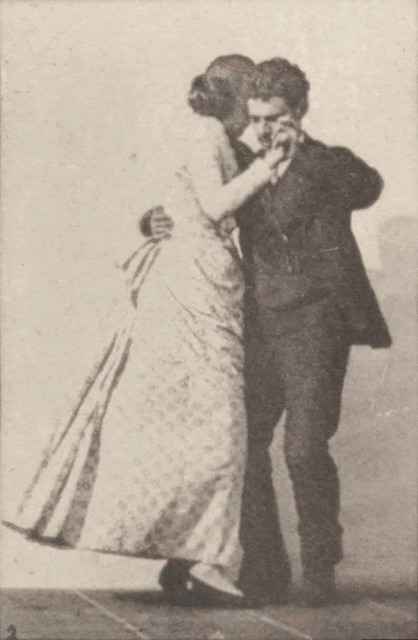Eadweard Muybridge And His Waltzing Couple, 1884
Updated: Apr 15

Before the advent of the film camera, a decade preceding the iconic Roundhay Garden Scene of 1888 and twelve years ahead of the Lumiere brothers' Arrival of a Train at La Ciotat in 1886, Eadweard Muybridge pioneered the creation of motion pictures.
Employing as many as 24 still cameras, Muybridge embarked on a groundbreaking endeavor over 140 years ago with his project titled "Animal Locomotion." This innovative undertaking commenced with his iconic Horse in Motion series in 1878 and culminated in a comprehensive exploration carried out at the University of Pennsylvania between 1884 and 1885.
Featured in the captivating tableau of Man and Woman Dancing a Waltz is Blanche Eplar, a figure etched into the annals of Muybridge's motion studies. Although the man's identity remains shrouded in mystery, speculation suggests he might have been a member of Muybridge's team enlisted for the session. This mesmerising glimpse into human movement likely dates back to 1884, encapsulating Muybridge's quest to unravel the intricacies of motion through his lens.

Born in Kingston upon Thames, Surrey, England, Eadweard Muybridge embarked on a transformative journey that would shape the course of photography and motion studies. At the age of 20, he immigrated to the United States, initially working as a bookseller in New York City before settling in San Francisco. However, his plans for a return trip to Europe in 1860 were abruptly interrupted when he suffered severe head injuries in a stagecoach accident in Texas. This incident led to a period of recuperation back in Kingston upon Thames, during which Muybridge delved into professional photography, mastering the wet-plate collodion process and securing British patents for his inventions.
Reinvigorated by his newfound passion, Muybridge returned to San Francisco in 1867, where he underwent a significant transformation both professionally and personally. In 1868, he gained recognition for his exhibition of large photographs showcasing the majestic landscapes of Yosemite Valley, marking the beginning of his ascent in the world of photography. Concurrently, Muybridge began producing and selling stereographs of his work, captivating audiences with his immersive imagery.

However, Muybridge's life took a tumultuous turn in 1874 when he was involved in a scandalous incident. He fatally shot Major Harry Larkyns, his wife's lover, a crime for which he stood trial. Despite the controversial circumstances surrounding the case, Muybridge was acquitted on the grounds of justifiable homicide. Undeterred by the ordeal, he embarked on a photographic expedition through Central America in 1875, further cementing his reputation as a daring explorer and pioneering photographer.
Muybridge's most enduring legacy lies in his pioneering work in chronophotography, conducted between 1878 and 1886. Utilising multiple cameras to capture sequential images of animal locomotion, he meticulously documented the nuances of movement, laying the groundwork for the study of biomechanics and animation. Additionally, his invention of the zoopraxiscope, a precursor to modern cinematography, enabled the projection of motion pictures from glass discs, revolutionising visual entertainment.

During his tenure at the University of Pennsylvania in Philadelphia from 1883 to 1886, Muybridge embarked on a prolific period of experimentation, producing over 100,000 images of animals and humans in motion. His meticulous documentation of movement extended beyond the realm of human perception, capturing moments imperceptible to the naked eye.
In his later years, Muybridge became a celebrated figure, captivating audiences with his public lectures and demonstrations of his groundbreaking photography and motion picture sequences. He traversed England and Europe, sharing his innovations with eager audiences in cities such as London and Paris. Muybridge's influential compilations of his work continue to inspire visual artists and practitioners in scientific and industrial photography.
Ultimately, Muybridge retired to his native England in 1894, leaving behind a profound legacy that transcends boundaries of time and space. His pioneering contributions to photography and motion studies endure, immortalised in the collections of institutions such as the Kingston Museum, which proudly houses a substantial collection of his works. Even in death, Muybridge's legacy lives on, a testament to the enduring power of innovation and exploration.

